Elena Aznar Gimeno (NANBIOSIS U26) leads a CIBER-BBN transfer project.
The CIBER-BBN transfer program, with its call for transfer projects, has selected two projects for next year with the aim of promoting the transfer of scientific or technological results, derived from the research carried out by the CIBER-BBN groups, to the industrial sector.
One of these projects selected is directed by Elena Aznar Gimeno, researcher from the group led by Ramon Martínez Máñez at the IDM-Polytechnic University of Valencia, together with an external group led by Javier Pemán García, from the La Fe Health Research Institute From Valencia.
The project has been jointly financed by CIBER-BBN and a company interested in the technology and will count with the participation of NANBIOSIS Unit 26 Biomedical Applications II
The CIBER-BBN call for transfer projects, which is now in its eighth edition, has financed fourteen projects with as many companies since its creation.























